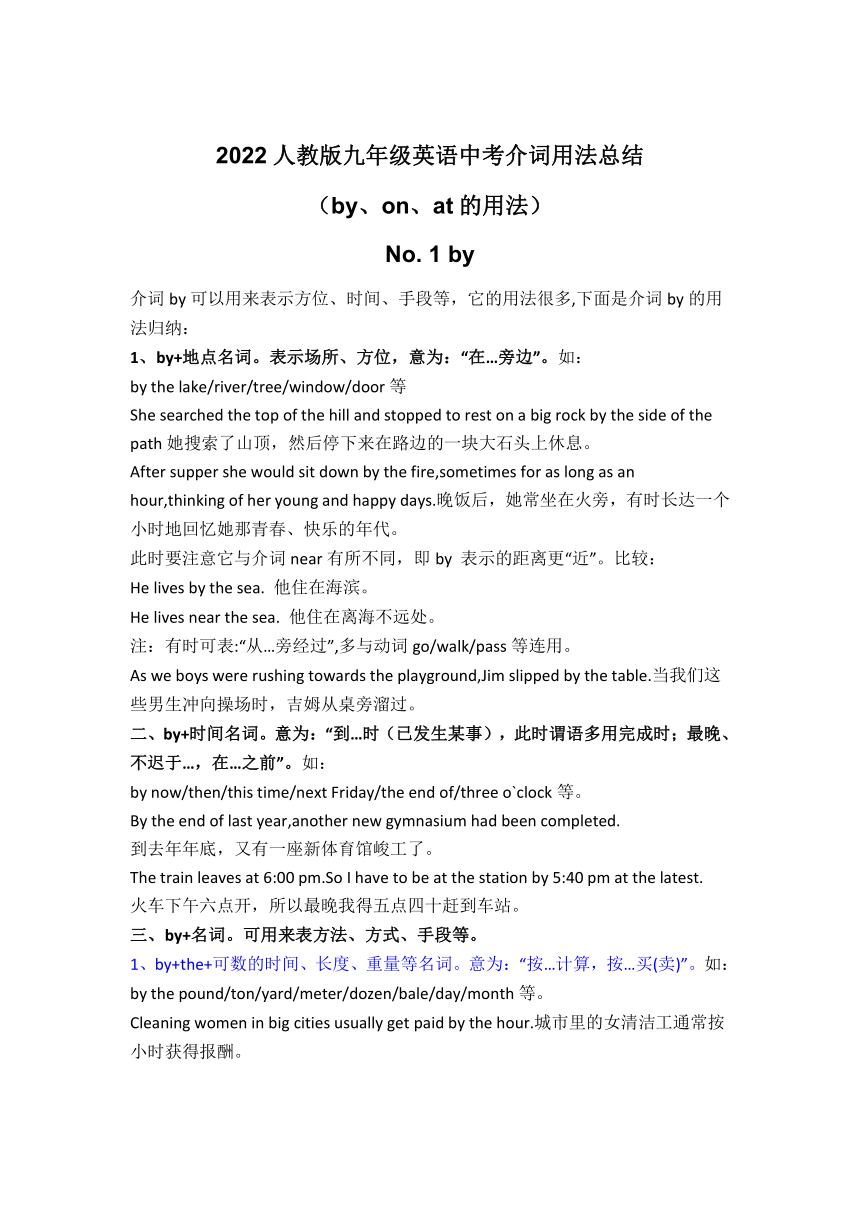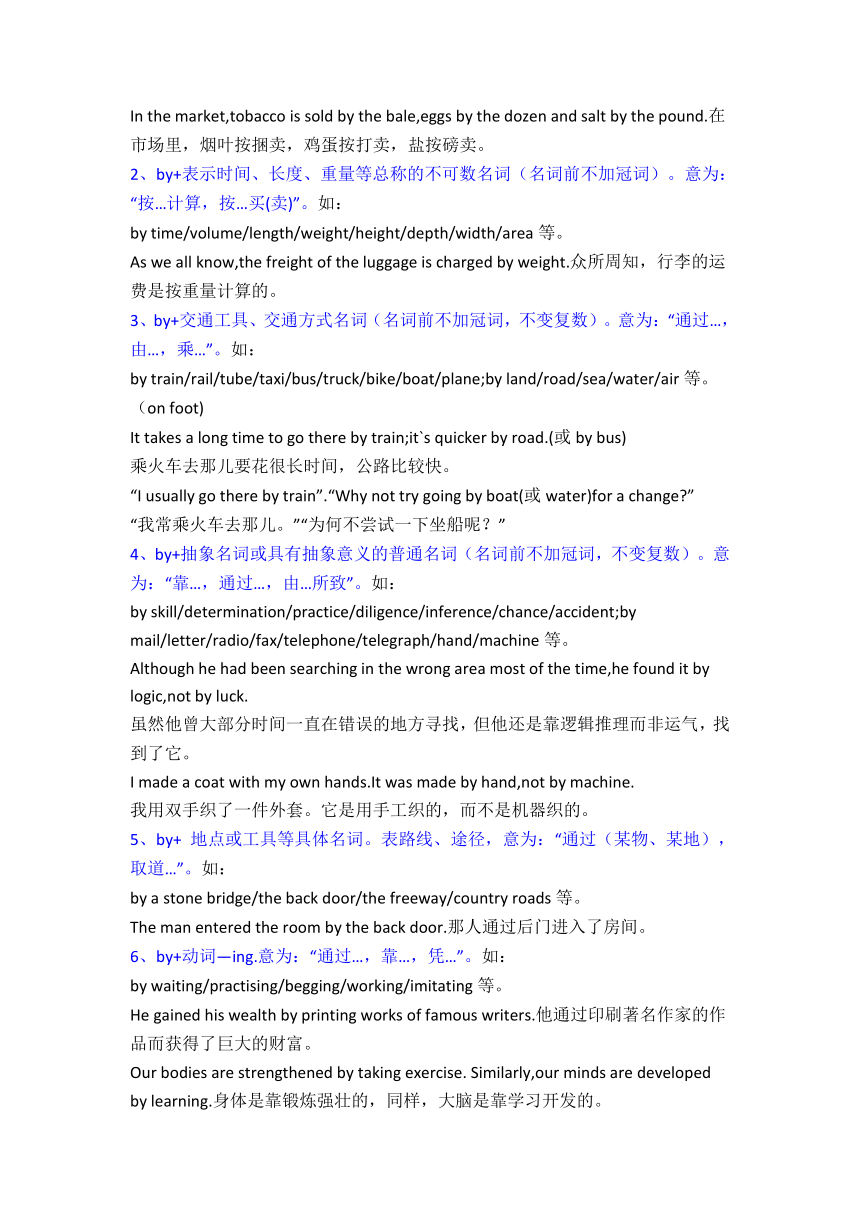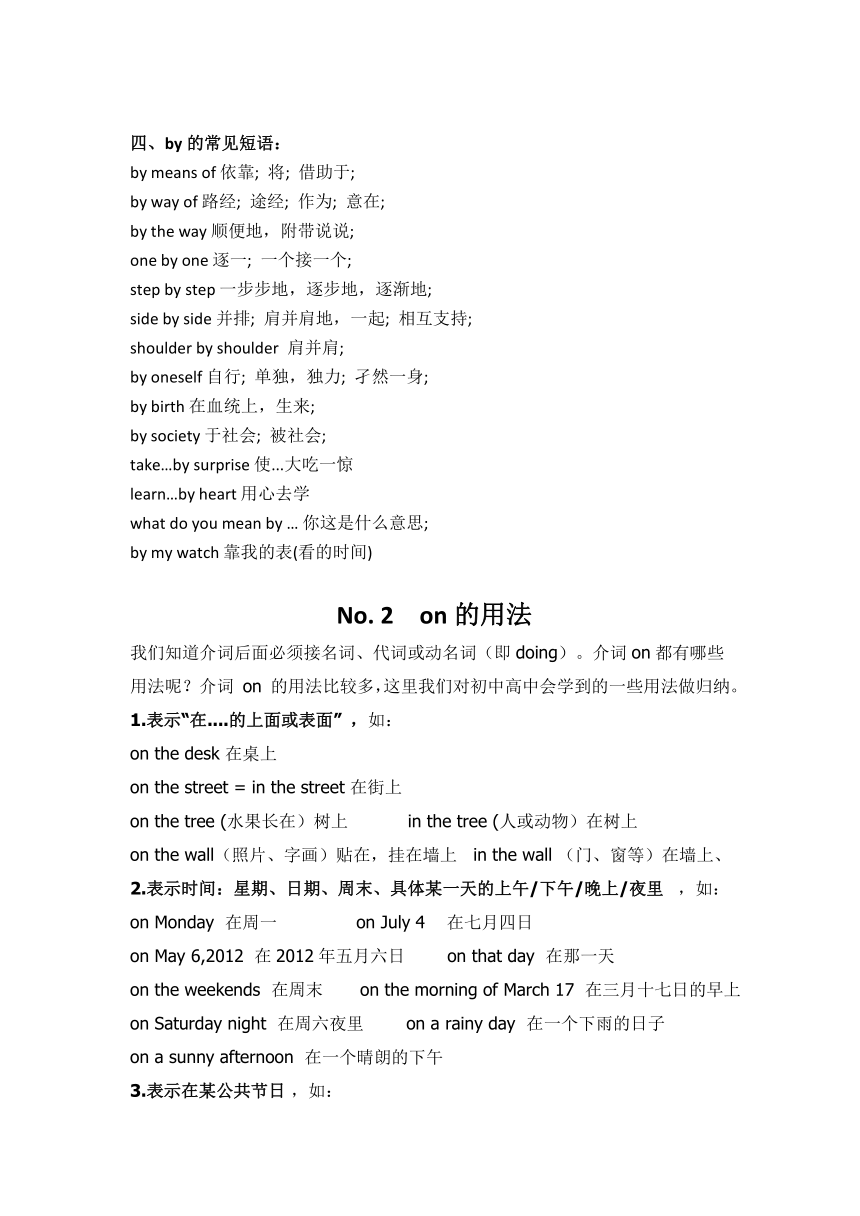2022年人教版英语九年级中考重要介词用法:by、at、on(word版)
文档属性
| 名称 | 2022年人教版英语九年级中考重要介词用法:by、at、on(word版) |

|
|
| 格式 | docx | ||
| 文件大小 | 22.7KB | ||
| 资源类型 | 教案 | ||
| 版本资源 | 人教新目标(Go for it)版 | ||
| 科目 | 英语 | ||
| 更新时间 | 2022-02-03 21:01:04 | ||
图片预览



文档简介
2022人教版九年级英语中考介词用法总结
(by、on、at的用法)
No. 1 by
介词by可以用来表示方位、时间、手段等,它的用法很多,下面是介词by的用法归纳:
1、by+地点名词。表示场所、方位,意为:“在…旁边”。如:
by the lake/river/tree/window/door等
She searched the top of the hill and stopped to rest on a big rock by the side of the path她搜索了山顶,然后停下来在路边的一块大石头上休息。
After supper she would sit down by the fire,sometimes for as long as an hour,thinking of her young and happy days.晚饭后,她常坐在火旁,有时长达一个小时地回忆她那青春、快乐的年代。
此时要注意它与介词near有所不同,即by 表示的距离更“近”。比较:
He lives by the sea. 他住在海滨。
He lives near the sea. 他住在离海不远处。
注:有时可表:“从…旁经过”,多与动词go/walk/pass等连用。
As we boys were rushing towards the playground,Jim slipped by the table.当我们这些男生冲向操场时,吉姆从桌旁溜过。
二、by+时间名词。意为:“到…时(已发生某事),此时谓语多用完成时;最晚、不迟于…,在…之前”。如:
by now/then/this time/next Friday/the end of/three o`clock等。
By the end of last year,another new gymnasium had been completed.
到去年年底,又有一座新体育馆峻工了。
The train leaves at 6:00 pm.So I have to be at the station by 5:40 pm at the latest.
火车下午六点开,所以最晚我得五点四十赶到车站。
三、by+名词。可用来表方法、方式、手段等。
1、by+the+可数的时间、长度、重量等名词。意为:“按…计算,按…买(卖)”。如:
by the pound/ton/yard/meter/dozen/bale/day/month等。
Cleaning women in big cities usually get paid by the hour.城市里的女清洁工通常按小时获得报酬。
In the market,tobacco is sold by the bale,eggs by the dozen and salt by the pound.在市场里,烟叶按捆卖,鸡蛋按打卖,盐按磅卖。
2、by+表示时间、长度、重量等总称的不可数名词(名词前不加冠词)。意为:“按…计算,按…买(卖)”。如:
by time/volume/length/weight/height/depth/width/area等。
As we all know,the freight of the luggage is charged by weight.众所周知,行李的运费是按重量计算的。
3、by+交通工具、交通方式名词(名词前不加冠词,不变复数)。意为:“通过…,由…,乘…”。如:
by train/rail/tube/taxi/bus/truck/bike/boat/plane;by land/road/sea/water/air等。(on foot)
It takes a long time to go there by train;it`s quicker by road.(或by bus)
乘火车去那儿要花很长时间,公路比较快。
“I usually go there by train”.“Why not try going by boat(或water)for a change ”
“我常乘火车去那儿。”“为何不尝试一下坐船呢?”
4、by+抽象名词或具有抽象意义的普通名词(名词前不加冠词,不变复数)。意为:“靠…,通过…,由…所致”。如:
by skill/determination/practice/diligence/inference/chance/accident;by mail/letter/radio/fax/telephone/telegraph/hand/machine等。
Although he had been searching in the wrong area most of the time,he found it by logic,not by luck.
虽然他曾大部分时间一直在错误的地方寻找,但他还是靠逻辑推理而非运气,找到了它。
I made a coat with my own hands.It was made by hand,not by machine.
我用双手织了一件外套。它是用手工织的,而不是机器织的。
5、by+ 地点或工具等具体名词。表路线、途径,意为:“通过(某物、某地),取道…”。如:
by a stone bridge/the back door/the freeway/country roads等。
The man entered the room by the back door.那人通过后门进入了房间。
6、by+动词—ing.意为:“通过…,靠…,凭…”。如:
by waiting/practising/begging/working/imitating等。
He gained his wealth by printing works of famous writers.他通过印刷著名作家的作品而获得了巨大的财富。
Our bodies are strengthened by taking exercise. Similarly,our minds are developed by learning.身体是靠锻炼强壮的,同样,大脑是靠学习开发的。
四、by的常见短语:
by means of 依靠; 将; 借助于;
by way of 路经; 途经; 作为; 意在;
by the way 顺便地,附带说说;
one by one 逐一; 一个接一个;
step by step 一步步地,逐步地,逐渐地;
side by side 并排; 肩并肩地,一起; 相互支持;
shoulder by shoulder 肩并肩;
by oneself 自行; 单独,独力; 孑然一身;
by birth 在血统上,生来;
by society 于社会; 被社会;
take…by surprise 使...大吃一惊
learn…by heart 用心去学
what do you mean by … 你这是什么意思;
by my watch 靠我的表(看的时间)
No. 2 on的用法
我们知道介词后面必须接名词、代词或动名词(即doing)。介词on都有哪些用法呢?介词 on 的用法比较多,这里我们对初中高中会学到的一些用法做归纳。
1.表示“在....的上面或表面” ,如:
on the desk 在桌上
on the street = in the street 在街上
on the tree (水果长在)树上 in the tree (人或动物)在树上
on the wall(照片、字画)贴在,挂在墙上 in the wall (门、窗等)在墙上、
2.表示时间:星期、日期、周末、具体某一天的上午/下午/晚上/夜里 ,如:
on Monday 在周一 on July 4 在七月四日
on May 6,2012 在2012年五月六日 on that day 在那一天
on the weekends 在周末 on the morning of March 17 在三月十七日的早上
on Saturday night 在周六夜里 on a rainy day 在一个下雨的日子
on a sunny afternoon 在一个晴朗的下午
3.表示在某公共节日 ,如:
on children’s Day 在儿童节
on Christmas Day 在圣诞节
on Thanksgiving Day 在感恩节
4.表示方位(外部接壤),两地相连接,毗邻 ,如:
on the left/right 在左边/右边 on the north of... 在...北边
North Korea is on the north of South Korea. 朝鲜在韩国的北部。
5.表示“关于”=about ,如:
A book on history 一本关于历史的书
6.表示“正开着”“正放映中” ,如:
The movie is on. 电影正在放映。 The TV is on. 电视是开着的。
The light is on. 灯是开着的。
7.表示“乘、坐、骑”,如:
on the train 坐火车 on the plane 坐飞机
on a horse 骑马 on a bus 坐公交
on my bike 骑自行车
8.表示“处于...状态中” ,如:
on holiday/vacation 在度假 on fire 着火了,起火了
9.表示“在....的边上” ,如:
on both sides of the street 在街道的两边
on the other side of desk 在桌子的另一边
10.表示“在...拐角处” ,如:
①in the corner 在....里面的拐角处,如:
There is a table in the corner of the room.房间的拐角处有张桌子。
②on the corner 在...的拐角上,如:
There is a cup on the corner of the table. 桌子的角上有个杯子。
③at the corner 在...拐角外面,如回答问路时:
Please turn left at the corner of the building.请在大楼拐角处左转。
11.表示“在....组队里”“是....的成员”(有时也可用in表示),如:
He is on the school football team. 他是学校足球队的一员。
12.常用带有on的固定词组
depend on 依靠,取决于= rely on
on the farm 在农场里 on the beach 在沙滩上
on the island 在岛上 on the earth/moon 在地球上/在月球上
on TV/QQ/radio 在电视上,在QQ上,在广播里 on the Internet 在网上
put on 穿(衣物) go on 进行,继续 turn on 打开
on duty 值日,值班
spend + 时间/钱 + on + 名词 在某物上花了多少时间或金钱
on foot 步行,走路
on time 准时= on schedule
on show 在展览= on display on sale 在出售
keep an eye on 密切关注
No. 3 at 的用法
我们知道介词后面必须接名词、代词或动名词(即doing)。介词at都有哪些用法呢?介词 at 往往表示一个具体的内容,相当于常说的一个“节点”。他的用法归纳如下:
1、用在时间上表示某个“点,时刻”,如几点几分,在中午、在当前等。
at 10 o'clcok 在10点
at a quarter to five 在4:45分
at daybreak 日出时
at that time 在当时
The meeting terminated at 12 o'clock.
会议于12点结束。
We will deliver your mattress tomorrow at 12 o'clock.
我们会在明天12点的时候把床垫寄送给您。
At the beginning of this term the teacher in charge of our class was very strict with us.
这学期开始,我们的班主任老师对我们要求非常严格。
2、表示地点时用于较小的地方、用于门牌号码前。如:
I shall wait for you at the station. 我将在车站等你。
He lives at 115 Zhongshan Road. 他住在中山路115号。
注意:它与介词 in 的相同和不同之处:有时若不严格区别,两者可以换用。如:
The meeting was held at [in] the hotel. 会议在宾馆举行。
但是,如果我们想到的是位置,一般用 at;如果想到的是空间,一般用in。如:
Let’s meet at the station. 我们在车站见吧。
Nobody was in the classroom. 教室里没有一个人。
两者的另一个区别是:较大的地方用in,较小的地方用 at。如:
in London 在伦敦 in the world 在世界上
at the airport在机场 at the door 在门口
但大小是相对而言的,有时随着说话者的着眼点不同,大地方也可能用at(即将其视为一个点)。如:
Our plane refueled at London. 我们的飞机在伦敦加油。
3、at 还常常用于表示速度、 价格、温度等。
The train runs at fifty kilometres an hour.
火车每小时行驶50公里。
We built the plant at top speed and minimun cost.
我们以最低的投资,最高的速度修建了该工厂。
at ten degrees centigrade 在摄氏10度
at minus ten degrees centigrade 摄氏零下10度
at the rate of 45 miles an hour 以每小时45英里的速度
at full/high speed 全速/高速
at 1000 RPM (revolution per minute) 每分钟1000转
at a good price 高价
at a low/great cost 低成本/高成本
4、表示“从事”或“正在做”,其后接的名词通常不用冠词。如:
at cards 在玩牌 at work 在工作
at war 在交战 at lunch 在吃中饭
at table 在吃饭 at school 在上课
但也有少数搭配习惯上要用冠词。如:
at the desk 在读书 at the telephone 在打电话
5、 at 可以与“人名+’s”连用,指其家或工作处。如:
We had lunch at Bill’s. 我们在比尔家吃了午饭。
I spent the weekend at my grandmother’s. 周末我是在奶奶家度过的。
I bought some rolls at the baker’s. 我在面包店里买些圆面包。
6、 表示目的或目标,在某些搭配中,at 往往含有主观上的不友好意味或恶意;相同情况下,若将at改为to,意思则大不一样。比较:
The dog came at me. 狗向我扑来。(意即咬人)
The dog came to me. 狗向我走过来。(无咬人之意)
He threw the ball at me. 他把球向我砸来(意欲打人)
He threw the ball to me. 他把球抛给我(无打人之意)
He shouted at me. 他对我吼叫。(意在训人)
He shouted to me. 他朝着我大声喊。(无训人之意)
表示目标时,at 只表示行为本身,并不表示行为的结果。比较:
He shot at the bird, but missed. 他向鸟射击,但未射中。
He shot the bird. 他射中了那只鸟。
7、动词+ at.at表示“指向某一目标,到达某地”:
arrive at抵达 call at访问某地
catch at(it)当场抓住 fire at向…开火
knock at敲 laugh at嘲笑
look at看一眼 smile at向某人微笑,
shoot at朝…射击, stare at怒目而视,
8、be +形容词/过去分词+ at.其中at表示“情绪、情感的原因,或对某物具有某种感情”:
be angry at恼怒于, be bad at不擅长,
be clever at对某事很灵巧,be delighted at高兴,
be disgusted at厌恶, be disappointed at对…失望,
be good at擅长, be mad at狂热于,
be pleased at对…感到高兴,be surprised at吃惊,
9、通常表示地点、场所、活动等,通常用汉语的“在”翻译,但有时它可以表示起点,相当于汉语“从”。如:
Everybody, we begin at page 50 today. 各位,我们今天从第50页开始。
(by、on、at的用法)
No. 1 by
介词by可以用来表示方位、时间、手段等,它的用法很多,下面是介词by的用法归纳:
1、by+地点名词。表示场所、方位,意为:“在…旁边”。如:
by the lake/river/tree/window/door等
She searched the top of the hill and stopped to rest on a big rock by the side of the path她搜索了山顶,然后停下来在路边的一块大石头上休息。
After supper she would sit down by the fire,sometimes for as long as an hour,thinking of her young and happy days.晚饭后,她常坐在火旁,有时长达一个小时地回忆她那青春、快乐的年代。
此时要注意它与介词near有所不同,即by 表示的距离更“近”。比较:
He lives by the sea. 他住在海滨。
He lives near the sea. 他住在离海不远处。
注:有时可表:“从…旁经过”,多与动词go/walk/pass等连用。
As we boys were rushing towards the playground,Jim slipped by the table.当我们这些男生冲向操场时,吉姆从桌旁溜过。
二、by+时间名词。意为:“到…时(已发生某事),此时谓语多用完成时;最晚、不迟于…,在…之前”。如:
by now/then/this time/next Friday/the end of/three o`clock等。
By the end of last year,another new gymnasium had been completed.
到去年年底,又有一座新体育馆峻工了。
The train leaves at 6:00 pm.So I have to be at the station by 5:40 pm at the latest.
火车下午六点开,所以最晚我得五点四十赶到车站。
三、by+名词。可用来表方法、方式、手段等。
1、by+the+可数的时间、长度、重量等名词。意为:“按…计算,按…买(卖)”。如:
by the pound/ton/yard/meter/dozen/bale/day/month等。
Cleaning women in big cities usually get paid by the hour.城市里的女清洁工通常按小时获得报酬。
In the market,tobacco is sold by the bale,eggs by the dozen and salt by the pound.在市场里,烟叶按捆卖,鸡蛋按打卖,盐按磅卖。
2、by+表示时间、长度、重量等总称的不可数名词(名词前不加冠词)。意为:“按…计算,按…买(卖)”。如:
by time/volume/length/weight/height/depth/width/area等。
As we all know,the freight of the luggage is charged by weight.众所周知,行李的运费是按重量计算的。
3、by+交通工具、交通方式名词(名词前不加冠词,不变复数)。意为:“通过…,由…,乘…”。如:
by train/rail/tube/taxi/bus/truck/bike/boat/plane;by land/road/sea/water/air等。(on foot)
It takes a long time to go there by train;it`s quicker by road.(或by bus)
乘火车去那儿要花很长时间,公路比较快。
“I usually go there by train”.“Why not try going by boat(或water)for a change ”
“我常乘火车去那儿。”“为何不尝试一下坐船呢?”
4、by+抽象名词或具有抽象意义的普通名词(名词前不加冠词,不变复数)。意为:“靠…,通过…,由…所致”。如:
by skill/determination/practice/diligence/inference/chance/accident;by mail/letter/radio/fax/telephone/telegraph/hand/machine等。
Although he had been searching in the wrong area most of the time,he found it by logic,not by luck.
虽然他曾大部分时间一直在错误的地方寻找,但他还是靠逻辑推理而非运气,找到了它。
I made a coat with my own hands.It was made by hand,not by machine.
我用双手织了一件外套。它是用手工织的,而不是机器织的。
5、by+ 地点或工具等具体名词。表路线、途径,意为:“通过(某物、某地),取道…”。如:
by a stone bridge/the back door/the freeway/country roads等。
The man entered the room by the back door.那人通过后门进入了房间。
6、by+动词—ing.意为:“通过…,靠…,凭…”。如:
by waiting/practising/begging/working/imitating等。
He gained his wealth by printing works of famous writers.他通过印刷著名作家的作品而获得了巨大的财富。
Our bodies are strengthened by taking exercise. Similarly,our minds are developed by learning.身体是靠锻炼强壮的,同样,大脑是靠学习开发的。
四、by的常见短语:
by means of 依靠; 将; 借助于;
by way of 路经; 途经; 作为; 意在;
by the way 顺便地,附带说说;
one by one 逐一; 一个接一个;
step by step 一步步地,逐步地,逐渐地;
side by side 并排; 肩并肩地,一起; 相互支持;
shoulder by shoulder 肩并肩;
by oneself 自行; 单独,独力; 孑然一身;
by birth 在血统上,生来;
by society 于社会; 被社会;
take…by surprise 使...大吃一惊
learn…by heart 用心去学
what do you mean by … 你这是什么意思;
by my watch 靠我的表(看的时间)
No. 2 on的用法
我们知道介词后面必须接名词、代词或动名词(即doing)。介词on都有哪些用法呢?介词 on 的用法比较多,这里我们对初中高中会学到的一些用法做归纳。
1.表示“在....的上面或表面” ,如:
on the desk 在桌上
on the street = in the street 在街上
on the tree (水果长在)树上 in the tree (人或动物)在树上
on the wall(照片、字画)贴在,挂在墙上 in the wall (门、窗等)在墙上、
2.表示时间:星期、日期、周末、具体某一天的上午/下午/晚上/夜里 ,如:
on Monday 在周一 on July 4 在七月四日
on May 6,2012 在2012年五月六日 on that day 在那一天
on the weekends 在周末 on the morning of March 17 在三月十七日的早上
on Saturday night 在周六夜里 on a rainy day 在一个下雨的日子
on a sunny afternoon 在一个晴朗的下午
3.表示在某公共节日 ,如:
on children’s Day 在儿童节
on Christmas Day 在圣诞节
on Thanksgiving Day 在感恩节
4.表示方位(外部接壤),两地相连接,毗邻 ,如:
on the left/right 在左边/右边 on the north of... 在...北边
North Korea is on the north of South Korea. 朝鲜在韩国的北部。
5.表示“关于”=about ,如:
A book on history 一本关于历史的书
6.表示“正开着”“正放映中” ,如:
The movie is on. 电影正在放映。 The TV is on. 电视是开着的。
The light is on. 灯是开着的。
7.表示“乘、坐、骑”,如:
on the train 坐火车 on the plane 坐飞机
on a horse 骑马 on a bus 坐公交
on my bike 骑自行车
8.表示“处于...状态中” ,如:
on holiday/vacation 在度假 on fire 着火了,起火了
9.表示“在....的边上” ,如:
on both sides of the street 在街道的两边
on the other side of desk 在桌子的另一边
10.表示“在...拐角处” ,如:
①in the corner 在....里面的拐角处,如:
There is a table in the corner of the room.房间的拐角处有张桌子。
②on the corner 在...的拐角上,如:
There is a cup on the corner of the table. 桌子的角上有个杯子。
③at the corner 在...拐角外面,如回答问路时:
Please turn left at the corner of the building.请在大楼拐角处左转。
11.表示“在....组队里”“是....的成员”(有时也可用in表示),如:
He is on the school football team. 他是学校足球队的一员。
12.常用带有on的固定词组
depend on 依靠,取决于= rely on
on the farm 在农场里 on the beach 在沙滩上
on the island 在岛上 on the earth/moon 在地球上/在月球上
on TV/QQ/radio 在电视上,在QQ上,在广播里 on the Internet 在网上
put on 穿(衣物) go on 进行,继续 turn on 打开
on duty 值日,值班
spend + 时间/钱 + on + 名词 在某物上花了多少时间或金钱
on foot 步行,走路
on time 准时= on schedule
on show 在展览= on display on sale 在出售
keep an eye on 密切关注
No. 3 at 的用法
我们知道介词后面必须接名词、代词或动名词(即doing)。介词at都有哪些用法呢?介词 at 往往表示一个具体的内容,相当于常说的一个“节点”。他的用法归纳如下:
1、用在时间上表示某个“点,时刻”,如几点几分,在中午、在当前等。
at 10 o'clcok 在10点
at a quarter to five 在4:45分
at daybreak 日出时
at that time 在当时
The meeting terminated at 12 o'clock.
会议于12点结束。
We will deliver your mattress tomorrow at 12 o'clock.
我们会在明天12点的时候把床垫寄送给您。
At the beginning of this term the teacher in charge of our class was very strict with us.
这学期开始,我们的班主任老师对我们要求非常严格。
2、表示地点时用于较小的地方、用于门牌号码前。如:
I shall wait for you at the station. 我将在车站等你。
He lives at 115 Zhongshan Road. 他住在中山路115号。
注意:它与介词 in 的相同和不同之处:有时若不严格区别,两者可以换用。如:
The meeting was held at [in] the hotel. 会议在宾馆举行。
但是,如果我们想到的是位置,一般用 at;如果想到的是空间,一般用in。如:
Let’s meet at the station. 我们在车站见吧。
Nobody was in the classroom. 教室里没有一个人。
两者的另一个区别是:较大的地方用in,较小的地方用 at。如:
in London 在伦敦 in the world 在世界上
at the airport在机场 at the door 在门口
但大小是相对而言的,有时随着说话者的着眼点不同,大地方也可能用at(即将其视为一个点)。如:
Our plane refueled at London. 我们的飞机在伦敦加油。
3、at 还常常用于表示速度、 价格、温度等。
The train runs at fifty kilometres an hour.
火车每小时行驶50公里。
We built the plant at top speed and minimun cost.
我们以最低的投资,最高的速度修建了该工厂。
at ten degrees centigrade 在摄氏10度
at minus ten degrees centigrade 摄氏零下10度
at the rate of 45 miles an hour 以每小时45英里的速度
at full/high speed 全速/高速
at 1000 RPM (revolution per minute) 每分钟1000转
at a good price 高价
at a low/great cost 低成本/高成本
4、表示“从事”或“正在做”,其后接的名词通常不用冠词。如:
at cards 在玩牌 at work 在工作
at war 在交战 at lunch 在吃中饭
at table 在吃饭 at school 在上课
但也有少数搭配习惯上要用冠词。如:
at the desk 在读书 at the telephone 在打电话
5、 at 可以与“人名+’s”连用,指其家或工作处。如:
We had lunch at Bill’s. 我们在比尔家吃了午饭。
I spent the weekend at my grandmother’s. 周末我是在奶奶家度过的。
I bought some rolls at the baker’s. 我在面包店里买些圆面包。
6、 表示目的或目标,在某些搭配中,at 往往含有主观上的不友好意味或恶意;相同情况下,若将at改为to,意思则大不一样。比较:
The dog came at me. 狗向我扑来。(意即咬人)
The dog came to me. 狗向我走过来。(无咬人之意)
He threw the ball at me. 他把球向我砸来(意欲打人)
He threw the ball to me. 他把球抛给我(无打人之意)
He shouted at me. 他对我吼叫。(意在训人)
He shouted to me. 他朝着我大声喊。(无训人之意)
表示目标时,at 只表示行为本身,并不表示行为的结果。比较:
He shot at the bird, but missed. 他向鸟射击,但未射中。
He shot the bird. 他射中了那只鸟。
7、动词+ at.at表示“指向某一目标,到达某地”:
arrive at抵达 call at访问某地
catch at(it)当场抓住 fire at向…开火
knock at敲 laugh at嘲笑
look at看一眼 smile at向某人微笑,
shoot at朝…射击, stare at怒目而视,
8、be +形容词/过去分词+ at.其中at表示“情绪、情感的原因,或对某物具有某种感情”:
be angry at恼怒于, be bad at不擅长,
be clever at对某事很灵巧,be delighted at高兴,
be disgusted at厌恶, be disappointed at对…失望,
be good at擅长, be mad at狂热于,
be pleased at对…感到高兴,be surprised at吃惊,
9、通常表示地点、场所、活动等,通常用汉语的“在”翻译,但有时它可以表示起点,相当于汉语“从”。如:
Everybody, we begin at page 50 today. 各位,我们今天从第50页开始。
同课章节目录
- 词法
- 名词
- 动词和动词短语
- 动词语态
- 动词时态
- 助动词和情态动词
- 非谓语动词
- 冠词
- 代词
- 数词和量词
- 形容词副词及其比较等级
- 介词和介词短语
- 连词和感叹词
- 构词法
- 相似、相近词比较
- 句法
- 陈述句
- 一般疑问句和否定疑问句
- 特殊疑问句及选择疑问句
- 反意疑问句
- 存在句(There be句型)
- 宾语从句
- 定语从句
- 状语从句
- 主谓一致问题
- 简单句
- 并列句
- 复合句
- 主谓一致
- 主、表语从句
- 名词性从句
- 直接引语和间接引语
- 虚拟语气
- 感叹句
- 强调句
- 倒装句
- 祈使句
- 句子的成分
- 句子的分类
- 题型专区
- 单项选择部分
- 易错题
- 完形填空
- 阅读理解
- 词汇练习
- 听说训练
- 句型转换
- 补全对话
- 短文改错
- 翻译
- 书面表达
- 任务型阅读
- 语法填空
- 其他资料
